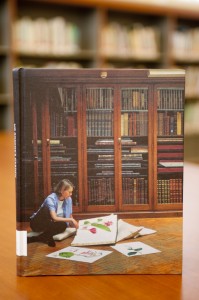From the Library: Mr. Roscoe’s Garden
Posted in From the Library on April 25 2012, by Matt Newman
 Not many can recall the Liverpool Botanic Gardens. Though its glasshouse and extensive collection of orchids saw thousands of visitors pass through in the early decades of their existence, the middle years of the twentieth century were not kind. After over a century of high regard, the 1930s and ’40s brought the second World War, along with an errant German bomb that destroyed much of the botanic glasshouse and its contents. A decade-long effort to rebuild the architecture on a post-war budget proved shoddy, and within 15 years the replacement structure had fallen into disrepair. By the rapid decline of the 1970s, the glasshouse’s rotting wooden framework and broken glass panes had become emblematic of Liverpool’s floundering economy.
Not many can recall the Liverpool Botanic Gardens. Though its glasshouse and extensive collection of orchids saw thousands of visitors pass through in the early decades of their existence, the middle years of the twentieth century were not kind. After over a century of high regard, the 1930s and ’40s brought the second World War, along with an errant German bomb that destroyed much of the botanic glasshouse and its contents. A decade-long effort to rebuild the architecture on a post-war budget proved shoddy, and within 15 years the replacement structure had fallen into disrepair. By the rapid decline of the 1970s, the glasshouse’s rotting wooden framework and broken glass panes had become emblematic of Liverpool’s floundering economy.
The Gardens closed without ceremony in 1984. With an unresolved labor dispute muddying the ground between the city council and the botanical workforce, Liverpool’s decision to shutter the space was labeled an act of political spite. What remained of the LBG’s extensive plant collection–now orphaned–was moved off-grounds. And, to some, the untold beauty and presence of a world-renowned paradise of exotic plants was lost to time.
Today the landscape of the Liverpool Botanic Gardens is far removed from what it once was, now a park and memorial for an erstwhile landmark. But in artist Jyll Bradley’s book, the rich past of one of Britain’s finest plant collections lives on; Mr. Roscoe’s Garden opens a vista to Liverpool’s extraordinary and oft-overlooked botanical history.
It was the cover of this book that first caught the eye of the NYBG‘s Reference Librarian, Mia D’Avanza, whose appreciation is often piqued in the areas where art and science intersect.
“Mr. Roscoe’s Garden is a poignant and beautifully composed visual tour of what was once the Liverpool Botanic Gardens,” Mia writes. “Described by the author as ‘a personal visit to these gardens–a virtual visit that crosses time, space, and place,’ it combines historic paintings and photographs with modern portraits; reproduced herbarium sheets with images of living specimens; and ephemera from the institution’s 200-year history, gently invoking a collection that lives on despite having been closed since the 1980s.”
As a memorial to an almost-forgotten sanctuary, Mr. Roscoe’s Garden excels. More importantly, it’s books like these that inspire the inherent humanity in the pursuit of botanical excellence. Not only through science does the love of plants live on, but through art and history as well. So when you visit the NYBG, wind your way to the LuEsther T. Mertz Library to explore the old, the new, the rare, novel, and altogether fascinating. You don’t have to be a tenured professor to discover a text that spurs your inner green thumb.

